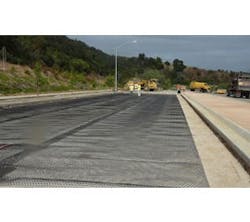San Diego Spruces Up Its Streets
The City of San Diego needed to maximize the value of available transportation funds by creating roadways that deliver long service lives with lower construction and maintenance costs. With this in mind, it decided to use the Spectra Roadway Improvement System—a mechanically stabilized layer incorporating Tensar TriAx Geogrid—to create a test platform as part of a road-widening project. The test compared two TriAx-reinforced sections against a standard, unreinforced section with a thick aggregate base.
The site conditions consisted of a subgrade with medium-dense to dense clayey sand with gravel and clayey gravels. The R-values along the alignment ranged from 26 to 34. The test control section consisted of 22 in of Class II aggregate base overlain with 5 in of asphalt concrete. (This type of section is frequently used in the region to support flexible pavement sections.)
The 16-in-thick test section included one layer of Tensar TX160 Geogrid reinforcement placed on 10 in of aggregate base above the subgrade. The 14-in-thick test section included one layer of TX7 Geogrid placed on 8 in of aggregate base above the subgrade. Southern California Soil & Testing (SCS&T) performed a series of laboratory and field tests to evaluate the test sections. These tests indicated that the thinner TriAx Geogrid designs outperformed the unreinforced section with 22 in of aggregate by increasing the modulus an average of 125%.
“We had experience with reinforcement but were still surprised by the results,” said SCS&T Principal Engineer Garrett Fountain. “The data analysis suggested we could have further reduced the TX7 section by 2 in and the TX160 section by 4 in.”
For years, the Spectra Roadway Improvement System featuring Tensar Geogrid has provided savings on the initial construction costs of flexible pavements by reducing the required pavement components’ thicknesses, including aggregate and asphalt. By reinforcing pavement structures with Tensar TriAx Geogrid, it is possible to save not only on aggregate and asphalt requirements, but also on future roadway maintenance and repair. Because of the unique mechanical interlocking mechanism of TriAx Geogrid, the stiffness of the unbound granular layers is increased and retained over time, creating a more reliable and longer-lasting pavement.
“The triangular grid structure provided a mechanically stabilized layer that allowed the city to construct a thinner, higher-performing and more cost-effective flexible pavement section,” said TIC Regional Manager Lars Nelson. “The TriAx design also reduced the carbon footprint, which complemented the City’s ‘Go Green’ game plan.”
With reduced aggregate or asphalt thicknesses, Geogrids help to reduce projects’ environmental impact. Tensar International has developed an independently verified calculation tool that can determine the carbon dioxide emissions associated with a Tensar Geogrid solution compared to the emissions produced using a conventional, thicker aggregate solution.
“The Spectra System also benefits budgets and schedules,” said Wayne George, the general superintendent for Aspen Construction, the project’s paving contractor. “It saved us a lot of time. If you’ve got a big job, TriAx Geogrid makes things go a lot faster.”
